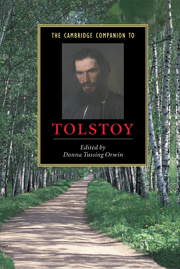Book contents
- Frontmatter
- Chronology
- Introduction
- Part 1 The three novels
- Part 2 Genres
- 4 Tolstoy as a writer of popular literature
- 5 The long short story in Tolstoy’s fiction
- 6 Tolstoy staged in Paris, Berlin, and London
- Part 3 General topics
- Guide to further reading
- Index to Tolstoy’s works and characters
- Generel Index
4 - Tolstoy as a writer of popular literature
from Part 2 - Genres
Published online by Cambridge University Press: 28 May 2006
- Frontmatter
- Chronology
- Introduction
- Part 1 The three novels
- Part 2 Genres
- 4 Tolstoy as a writer of popular literature
- 5 The long short story in Tolstoy’s fiction
- 6 Tolstoy staged in Paris, Berlin, and London
- Part 3 General topics
- Guide to further reading
- Index to Tolstoy’s works and characters
- Generel Index
Summary
In Tolstoy’s time the phrase “popular literature” (narodnaia literatura, “literature for or of the common people”) subsumed a variety of related products. It included, first, the literature of the people, especially the narrative forms of folklore: heroic songs, fairy tales, religious legends, and the like. Produced and orally perpetuated among the common people themselves, usually by quasi-professional performers, this category of popular literature assumed written or printed form only through the efforts of folklorists and other transcribers of its oral performance. Once such works became known it was not long before stylizations of them followed. These are clearly not “of the people” but imitate as closely as possible the spirit and forms of their models. Stylizations, particularly of the Russian fairy tale, are well represented in nineteenth-century Russian literature. Well-known examples are Pushkin’s Tale of the Fisherman and the Fish (Skazka o rybake i rybke), V. F. Odoevskii’s Moroz Ivanovich, S. T. Aksakov’s The Little Crimson Flower (Alen'kii tsvetochek), and P. P. Ershov’s The Little Humpbacked Horse (Konek-gorbunok). Tolstoy wrote many works, in particular his score or so of Stories for the People (narodnye rasskazy) which may be assigned to this category, but, as will appear below, not exclusively to it.
- Type
- Chapter
- Information
- The Cambridge Companion to Tolstoy , pp. 111 - 126Publisher: Cambridge University PressPrint publication year: 2002

